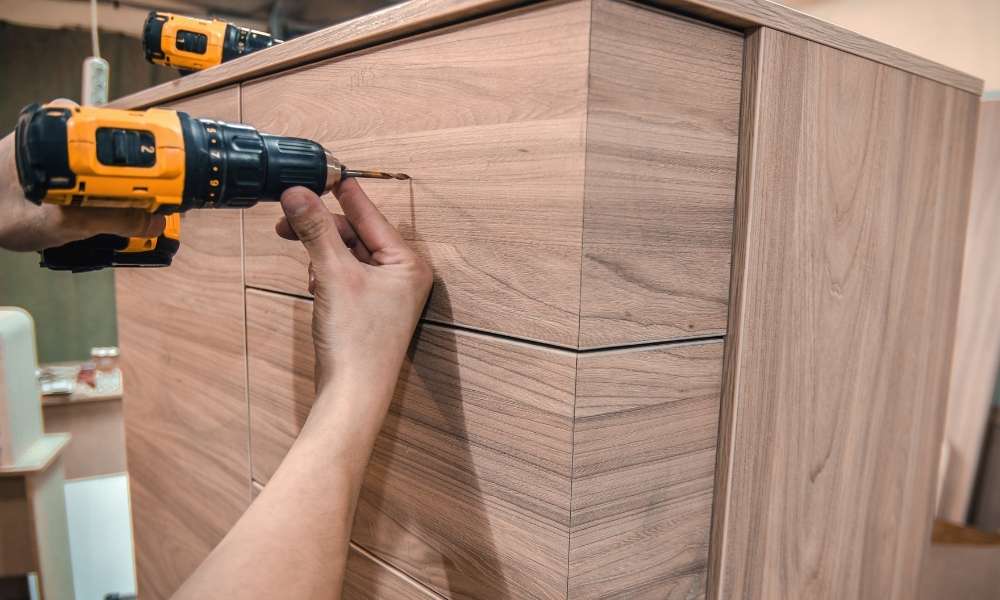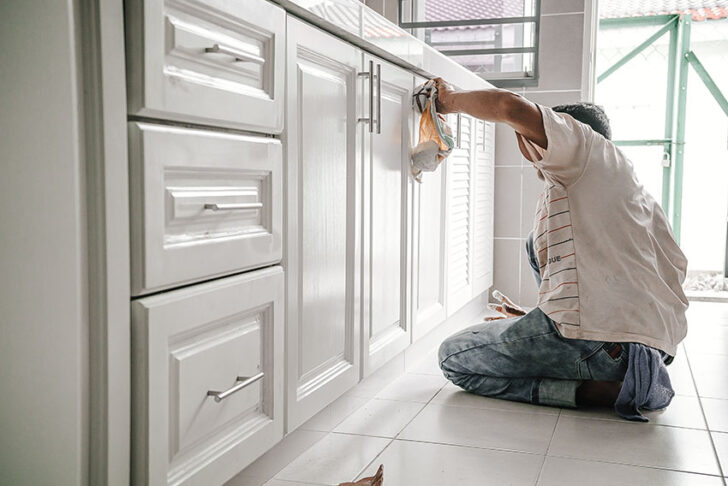Identifying the Cause of Worn Spots

Understanding the root cause of worn spots on your kitchen cabinets is crucial for effective repair and prevention. Worn spots can arise from various factors, including the type of materials used, the frequency of use, and the location of the cabinet.
Materials and Wear
The type of material used in your cabinets significantly influences their susceptibility to wear and tear.
- Wood: Wood is a natural material that can be prone to scratches, dents, and fading over time. The type of wood used, its finish, and the quality of the stain or paint all affect its durability.
- Laminate: Laminate surfaces are known for their durability and resistance to scratches and stains. However, they can still show signs of wear, especially in high-traffic areas.
- Paint: Painted cabinets can chip, scratch, and fade over time, particularly if they are exposed to moisture or sunlight.
- Metal: Metal cabinets are generally very durable and resistant to wear. However, they can dent or scratch if subjected to heavy impacts.
Wear Patterns
The location and frequency of use of your cabinets also influence wear patterns.
- Cabinet Doors: Cabinet doors, especially those near the sink or stove, are prone to wear from constant opening and closing. This can lead to scratches, dents, and fading around the handles and edges.
- Cabinet Corners: Corners of cabinets are vulnerable to bumps and scratches, particularly in areas with heavy foot traffic.
- Countertops: Countertops are subject to spills, scratches, and heat damage. This can cause wear on the cabinet surfaces below.
- High-Traffic Areas: Cabinets located in high-traffic areas, such as the pantry or near the refrigerator, are more likely to show signs of wear from frequent use.
Repairing Worn Spots

Once you’ve identified the cause of the worn spots on your kitchen cabinets, it’s time to address them. There are a few different methods you can use to repair these spots, each with its own advantages and disadvantages.
Sanding and Refinishing
Sanding and refinishing are effective methods for repairing worn spots on kitchen cabinets. They involve removing the damaged surface layer and applying a new finish.
- Sanding: Start by sanding the worn area with fine-grit sandpaper to smooth out the surface. Work in a circular motion, gradually increasing the grit level to remove deeper scratches and imperfections.
- Refinishing: After sanding, apply a new coat of paint or stain to the affected area. Choose a finish that matches the existing color and sheen of your cabinets. Apply multiple thin coats, allowing each layer to dry completely before applying the next.
Using Wood Filler
Wood filler is a paste-like material that can be used to fill in gaps, holes, and worn spots on wood surfaces. It comes in various colors and textures to match different types of wood.
- Application: Apply the wood filler to the worn spot using a putty knife. Press it firmly into the surface, ensuring it fills the entire area.
- Smoothing: After the filler has dried, smooth it out with sandpaper. Use a fine-grit sandpaper to blend the filler seamlessly with the surrounding wood.
- Finishing: Once the filler is smoothed, apply a coat of paint or stain to match the rest of the cabinet. This will help to hide the repair and create a uniform finish.
Comparing Repair Techniques
| Technique | Effectiveness | Durability |
|—|—|—|
| Sanding and Refinishing | Highly effective for removing deep scratches and imperfections | Durable if done properly, but may require touch-ups over time |
| Using Wood Filler | Effective for filling in gaps and holes | Durable, but may be susceptible to cracking or chipping if not applied correctly |
Preventing Future Wear and Tear: How To Fix Worn Spots On Kitchen Cabinets

Once you’ve successfully repaired worn spots on your kitchen cabinets, it’s crucial to take proactive steps to prevent further damage and extend their lifespan. Implementing preventive measures can help maintain the aesthetic appeal and functionality of your cabinets for years to come.
Strategies for Preventing Wear and Tear
Proactive measures can significantly reduce the likelihood of wear and tear on your kitchen cabinets. These strategies focus on protecting the surfaces, minimizing impact, and using appropriate cleaning methods.
| Strategy | Description |
|---|---|
| Protective Coatings | Applying a clear sealant or varnish to the cabinet surfaces creates a protective barrier against scratches, stains, and moisture. |
| Avoiding Harsh Cleaning Products | Using abrasive cleaners or harsh chemicals can damage the finish of your cabinets. Opt for mild, pH-neutral cleaners specifically designed for kitchen surfaces. |
| Minimizing Impact | Avoid slamming cabinet doors or drawers, as this can cause damage over time. Install soft-close hinges and drawer slides to prevent forceful closures. |
| Using Protective Pads | Place protective pads on the bottom of heavy items stored in cabinets to prevent scratches and dents on the shelves. |
| Regular Cleaning and Maintenance | Regularly clean your cabinets with a damp cloth and mild detergent to remove dust, grime, and food spills. |
Common Cabinet Materials and Wear Resistance
Understanding the properties of different cabinet materials can help you make informed choices when selecting materials for your kitchen.
- Wood: Natural wood is susceptible to scratches, dents, and water damage. Hardwood species like oak and maple are more durable than softer woods like pine. Applying a protective finish, such as varnish or polyurethane, can enhance resistance to wear and tear.
- Laminate: Laminate is a durable and affordable material that resists scratches, dents, and moisture. It’s often used for cabinet doors and drawer fronts.
- Melamine: Melamine is a durable, scratch-resistant material that’s often used for cabinet boxes and shelves. It’s less expensive than laminate but may not be as resistant to high heat.
- Thermofoil: Thermofoil is a plastic laminate that’s applied to a substrate like MDF. It’s known for its durability, moisture resistance, and affordability. However, it can be susceptible to scratches and dents.
- Painted Cabinets: Painted cabinets offer a wide range of colors and finishes. However, the paint can be prone to scratches and chips. A high-quality paint with a durable finish can help minimize these issues.
Importance of Regular Maintenance, How to fix worn spots on kitchen cabinets
Regular maintenance plays a crucial role in extending the lifespan of your kitchen cabinets. By addressing minor issues promptly and implementing preventive measures, you can keep your cabinets looking their best for years to come.
- Cleaning: Regularly clean your cabinets with a damp cloth and mild detergent to remove dust, grime, and food spills. This helps prevent the build-up of dirt and debris that can damage the finish.
- Inspection: Periodically inspect your cabinets for any signs of damage, such as scratches, dents, or loose hinges. Address these issues promptly to prevent them from worsening.
- Lubrication: Lubricate cabinet hinges and drawer slides regularly to ensure smooth operation and prevent wear and tear.
- Refinishing: If your cabinets show signs of significant wear, consider refinishing them to restore their appearance and protect the surfaces.
How to fix worn spots on kitchen cabinets – Giving your kitchen cabinets a fresh look is as simple as a little paint or stain. But if you’re looking for something a bit more luxurious, consider upgrading your storage with a top gear range rover gun cabinet for your prized possessions.
While you’re at it, why not tackle those worn spots on your kitchen cabinets with a touch of paint? You’ll be surprised at how much a little TLC can transform your space.
Don’t let those worn spots on your kitchen cabinets get you down! A little sanding and a fresh coat of paint can make them look brand new. And if you’re looking for a way to maximize storage space, consider incorporating shallow cabinets with doors into your design.
These clever cabinets can create a streamlined look while still offering ample storage. Once you’ve tackled those worn spots, you’ll be ready to enjoy your refreshed kitchen for years to come!
